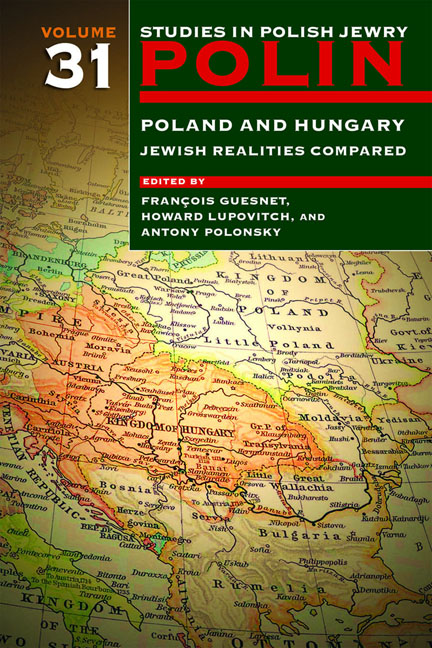Book contents
- Frontmatter
- Dedication
- Editors and Advisers
- Preface
- Polin
- Polin: Studies in Polish Jewry
- Contents
- Note on Place Names
- Note on Transliteration
- Part I POLAND AND HUNGARY: JEWISH REALITIES COMPARED
- JEWISH ACCULTURATION AND INTEGRATION
- JEWISH RELIGIOUS LIFE
- JEWS IN POPULAR CULTURE
- THE INTERWAR YEARS
- THE HOLOCAUST AND ITS AFTERMATH
- PERSONAL REFLECTIONS
- Part II NEW VIEWS
- Part III OBITUARIES
- Notes on the Contributors
- Index
Warsaw and Budapest, 1939–1945: Two Ghettos, Two Policies, Two Outcomes
- Frontmatter
- Dedication
- Editors and Advisers
- Preface
- Polin
- Polin: Studies in Polish Jewry
- Contents
- Note on Place Names
- Note on Transliteration
- Part I POLAND AND HUNGARY: JEWISH REALITIES COMPARED
- JEWISH ACCULTURATION AND INTEGRATION
- JEWISH RELIGIOUS LIFE
- JEWS IN POPULAR CULTURE
- THE INTERWAR YEARS
- THE HOLOCAUST AND ITS AFTERMATH
- PERSONAL REFLECTIONS
- Part II NEW VIEWS
- Part III OBITUARIES
- Notes on the Contributors
- Index
Summary
THIS CHAPTER will compare the histories of the Warsaw and Budapest ghettos. Prior to the Second World War a significant number of Jews lived in both cities; however, their fates were very different: of the 380,000 Jews living in Warsaw before the war only an estimated 11,500 survived, whereas out of the 200,000 Jews of Budapest more than 130,000 lived to see the liberation of Hungary. This chapter will attempt to explain this great difference. The history of the Warsaw ghetto is one of the best documented and researched topics of the Holocaust. A treatment of the Pest ghetto—a book still usable today—was written immediately after the war.
There are fairly precise figures available for the number of Jews living in Budapest for the century before the Second World War (see Table 1). To the data of the 1941 census must be added 22,122 individuals who were considered Jewish according to Article IV of the antisemitic law of 1939, of whom 13,966 were Roman Catholic, 4,232 Calvinist, and 3,222 Lutheran.
The number of Jews in the Hungarian capital significantly decreased from 1920 to 1941. One of the main reasons for this, apart from conversion, was ‘a dramatic drop in the rate of natural increase’. After 1941, when Hungary entered the war as an ally of Germany, this trend only intensified, since approximately 30,000 Jewish men perished during forced labour for the military.
The majority of religious Jews in the Hungarian capital belonged to the assimilationist Neolog movement, and the number of conversions and mixed marriages was high—between 1931 and 1942 there were 10,842 mixed marriages.
In Warsaw during the nineteenth century the percentage of Jews grew continually. In 1830 they constituted 25.0 per cent of the total population; in 1863, 32.6 per cent; in 1901, 35.8 per cent; and in 1917, 44.9 per cent. In 1938 the population of the capital of the Polish Republic was 1,265,372, of which 368,394 (23.1 per cent) were Jews. Most of them spoke Yiddish, a language unintelligible to the overwhelming majority of Hungarian Jews. In the Warsaw ghetto, whose population peaked at 400,000 in 1941, there were barely 2,000 converted Jews (0.5 per cent).
- Type
- Chapter
- Information
- Polin: Studies in Polish Jewry Volume 31Poland and Hungary: Jewish Realities Compared, pp. 381 - 394Publisher: Liverpool University PressPrint publication year: 2018



